Spatiotemporal Distribution and Evolution Characteristics of Water Traffic Accidents in Asia since the 21st Century
Abstract
:1. Introduction
2. Data Sources
3. Methodology
3.1. The Methods of Gravity Center and Standard Deviation Ellipse
3.2. Daniel Trend Test and R/S Analysis
4. Occurrence Analysis of Water Traffic Accidents
4.1. Time Series Analysis
4.1.1. Seasonal Distribution of Water Traffic Accidents
4.1.2. Yearly Distribution of Water Traffic Accidents, Deaths, and Affected Persons
4.2. Spatial Distribution Analysis
4.2.1. Spring Season
4.2.2. Summer Season
4.2.3. Autumn Season
4.2.4. Winter Season
5. Results and Discussion
5.1. Daniel Trend Test and R/S Analysis
5.1.1. Daniel Trend Test Analysis
5.1.2. R/S Analysis
5.2. Evolution Features of Standard Deviation Ellipse and Gravity Center
5.2.1. South-Eastern Asia
5.2.2. Eastern Asia
5.2.3. Southern Asia
5.2.4. Western Asia
5.3. Discussion
6. Conclusions
- Both South-eastern Asia and Southern Asia were identified as high incidence areas of water traffic accidents. Most of the accidents occur in September, October, and December, i.e., in autumn and winter. Overall, the occurrence frequency of water traffic accidents in Asia shows a feature of an upward trend at the beginning of the 21st century, a fluctuating decline till 2020 and a minor increasing trend in 2022.
- Heat maps and scatter diagrams were presented to demonstrate the distribution patterns of water traffic accidents in different sub-regions. The regional and seasonal evolution trends are anticipated to persist for 4~6 years and 3~5 years, respectively, based on the Daniel trend analysis and Hurst coefficients calculations.
- The spatial analysis of water traffic accident data demonstrates that the gravity center of Asia is located at the junction between India and Bangladesh. The evolution features of different sub-regions were presented and analyzed. The geographical conditions, industrial planning, and development strategies of Asian countries might have an impact on the distribution and evolution characteristics of water traffic accidents. The potential causes of accidents were also briefly discussed for different sub-regions.
Author Contributions
Funding
Institutional Review Board Statement
Informed Consent Statement
Data Availability Statement
Acknowledgments
Conflicts of Interest
References
- Tolliver, D.; Lu, P.; Benson, D. Comparing rail fuel efficiency with truck and waterway. Transp. Res. Part Transp. Environ. 2013, 24, 69–75. [Google Scholar] [CrossRef]
- Caris, A.; Limbourg, S.; Macharis, C.; Van Lier, T.; Cools, M. Integration of inland waterway transport in the intermodal supply chain: A taxonomy of research challenges. J. Transp. Geogr. 2014, 41, 126–136. [Google Scholar] [CrossRef]
- Dávid, A.; Madudová, E. The Danube river and its importance on the Danube countries in cargo transport. Transp. Res. Procedia 2019, 40, 1010–1016. [Google Scholar] [CrossRef]
- Ministry of Transport of the People’s Republic of China. Notice of the Ministry of Transport on the Issuance of the Outline for the Development of Inland Waterway; Ministry of Transport of the People’s Republic of China: Beijing, China, 2020. Available online: https://www.gov.cn/zhengce/zhengceku/2020-06/04/content_5517185.htm (accessed on 19 October 2023).
- Ministry of Ports, Shipping and Waterways Government of India. Maritime India Vision 2030; Ministry of Ports, Shipping and Waterways Government of India: New Delhi, India, 2021. Available online: https://sagarmala.gov.in/sites/default/files/MIV%202030%20Report.pdf (accessed on 19 October 2023).
- International Maritime Organization. 30 Years at IMO HQ; International Maritime Organization: London, UK, 2023. Available online: https://wwwcdn.imo.org/localresources/en/About/HistoryOfIMO/Documents/30%20years%20at%20IMO%20HQ.pdf (accessed on 19 October 2023).
- Bačkalov, I.; Vidić, M.; Rudaković, S. Lessons learned from accidents on some major European inland waterways. Ocean Eng. 2023, 273, 113918. [Google Scholar] [CrossRef]
- Cao, Y.; Wang, X.; Yang, Z.; Wang, J.; Wang, H.; Liu, Z. Research in marine accidents: A bibliometric analysis, systematic review and future directions. Ocean Eng. 2023, 284, 115048. [Google Scholar] [CrossRef]
- Huang, X.; Wen, Y.; Zhang, F.; Han, H.; Huang, Y.; Sui, Z. A review on risk assessment methods for maritime transport. Ocean Eng. 2023, 279, 114577. [Google Scholar] [CrossRef]
- Ma, L.; Ma, X.; Lan, H.; Liu, Y.; Deng, W. A methodology to assess the interrelationships between contributory factors to maritime transport accidents of dangerous goods in China. Ocean Eng. 2022, 266, 112769. [Google Scholar] [CrossRef]
- Md Hanafiah, R.; Zainon, N.S.; Karim, N.H.; Abdul Rahman, N.S.F.; Behforouzi, M.; Soltani, H.R. A new evaluation approach to control maritime transportation accidents: A study case at the Straits of Malacca. Case Stud. Transp. Policy 2022, 10, 751–763. [Google Scholar] [CrossRef]
- Fan, S.; Blanco-Davis, E.; Fairclough, S.; Zhang, J.; Yan, X.; Wang, J.; Yang, Z. Incorporation of seafarer psychological factors into maritime safety assessment. Ocean Coast. Manag. 2023, 237, 106515. [Google Scholar] [CrossRef]
- Fan, S.; Yang, Z. Towards objective human performance measurement for maritime safety: A new psychophysiological data-driven machine learning method. Reliab. Eng. Syst. Saf. 2023, 233, 109103. [Google Scholar] [CrossRef]
- Galieriková, A. The human factor and maritime safety. Transp. Res. Procedia 2019, 40, 1319–1326. [Google Scholar] [CrossRef]
- Crestelo Moreno, F.; Roca Gonzalez, J.; Suardíaz Muro, J.; García Maza, J.A. Relationship between human factors and a safe performance of vessel traffic service operators: A systematic qualitative-based review in maritime safety. Saf. Sci. 2022, 155, 105892. [Google Scholar] [CrossRef]
- Hu, P.; Zhang, Q.; Shi, P.; Chen, B.; Fang, J. Flood-induced mortality across the globe: Spatiotemporal pattern and influencing factors. Sci. Total Environ. 2018, 643, 171–182. [Google Scholar] [CrossRef]
- Lee, W.V. Historical global analysis of occurrences and human casualty of extreme temperature events (ETEs). Nat. Hazards 2014, 70, 1453–1505. [Google Scholar] [CrossRef]
- De Moraes, O.L.L. Some evidence on the reduction of the disasters impact due to natural hazards in the Americas and the Caribbean after the 1990s. Int. J. Disaster Risk Reduct. 2022, 75, 102984. [Google Scholar] [CrossRef]
- López-Peláez, J. Co-evolution between structural mitigation measures and urbanization in France and Colombia: A comparative analysis of disaster risk management policies based on disaster databases. Habitat Int. 2011, 35, 573–581. [Google Scholar] [CrossRef]
- Mavhura, E. Disaster mortalities and the Sendai Framework Target A: Insights from Zimbabwe. World Dev. 2023, 165, 106196. [Google Scholar] [CrossRef]
- Shi, S.; Yao, F.; Zhang, J.; Yang, S. Evaluation of Temperature Vegetation Dryness Index on Drought Monitoring Over Eurasia. IEEE Access 2020, 8, 30050–30059. [Google Scholar] [CrossRef]
- Fu, S.; Liu, Y.; Xi, Y.; Wan, H. Feature Analysis and Association Rule Mining of Sship Accidents in Arctic Waters. Adv. Polar Sci. 2020, 32, 102–111. [Google Scholar] [CrossRef]
- Lloyd’s List Intelligence. Shipping and Maritime Intelligence; Lloyd’s List Intelligence: London, UK, 2021; Available online: https://www.seasearcher.com/ (accessed on 22 October 2023).
- Adhikari, P.; Hong, Y.; Douglas, K.R.; Kirschbaum, D.B.; Gourley, J.; Adler, R.; Robert Brakenridge, G. A digitized global flood inventory (1998–2008): Compilation and preliminary results. Nat. Hazards 2010, 55, 405–422. [Google Scholar] [CrossRef]
- Klein, L.R. Measurement of a shift in the world’s center of economic gravity. J. Policy Model. 2009, 31, 489–492. [Google Scholar] [CrossRef]
- Grether, J.-M.; Mathys, N.A. Is the World’s Economic Center of Gravity Already in Asia? SSRN Electron. J. 2008, 42, 47–50. [Google Scholar] [CrossRef]
- Liang, L.; Chen, M.; Luo, X.; Xian, Y. Changes pattern in the population and economic gravity centers since the Reform and Opening up in China: The widening gaps between the South and North. J. Clean. Prod. 2021, 310, 127379. [Google Scholar] [CrossRef]
- Lefever, D.W. Measuring Geographic Concentration by Means of the Standard Deviational Ellipse. Am. J. Sociol. 1926, 32, 88–94. [Google Scholar] [CrossRef]
- Rogerson, P.A. Historical change in the large-scale population distribution of the United States. Appl. Geogr. 2021, 136, 102563. [Google Scholar] [CrossRef]
- Wei, C.; Guo, B.; Zhang, H.; Han, B.; Li, X.; Zhao, H.; Lu, Y.; Meng, C.; Huang, X.; Zang, W.; et al. Spatial–temporal evolution pattern and prediction analysis of flood disasters in China in recent 500 years. Earth Sci. Inform. 2022, 15, 265–279. [Google Scholar] [CrossRef]
- Liu, J.; Chen, T.; Chi, D. Rainfall trend analysis of the northwest Liaoning Province based on Daniel and Mann-Kendall test. J Shenyang Agric. Univ. Soc. Ed. 2014, 45, 599–603. [Google Scholar] [CrossRef]
- Liu, Y.; Yang, Z.; Huang, Y.; Liu, C. Spatiotemporal evolution and driving factors of China’s flash flood disasters since 1949. Sci. China Earth Sci. 2018, 61, 1804–1817. [Google Scholar] [CrossRef]
- International Maritime Organization. X-Press Pearl—Incident Information Centre; 9875343; International Maritime Organization: London, UK, 2021. Available online: https://www.x-presspearl-informationcentre.com/ (accessed on 22 October 2023).
- Hopkins, S. Economic stability and health status: Evidence from East Asia before and after the 1990s economic crisis. Health Policy 2006, 75, 347–357. [Google Scholar] [CrossRef] [PubMed]
- Zaman, M.B.; Kobayashi, E.; Wakabayashi, N.; Maimun, A. Risk of Navigation for Marine Traffic in the Malacca Strait Using AIS. Procedia Earth Planet. Sci. 2015, 14, 33–40. [Google Scholar] [CrossRef]
- Rusli, M. Navigational Hazards in International Maritime Chokepoints: A Study of the Straits of Malacca and Singapore. J. Int. Stud. 2020, 8, 47–75. [Google Scholar] [CrossRef]
- Bellina, B.; Favereau, A.; Dussubieux, L. Southeast Asian Early Maritime Silk Road trading polities’ hinterland and the sea-nomads of the Isthmus of Kra. J. Anthropol. Archaeol. 2019, 54, 102–120. [Google Scholar] [CrossRef]
- Schottenhammer, A. The “China Seas” in world history: A general outline of the role of Chinese and East Asian maritime space from its origins to c. 1800. J. Mar. Isl. Cult. 2012, 1, 63–86. [Google Scholar] [CrossRef]
- Chang, Y.-C.; Liu, S.; Zhang, X. The construction of Global Maritime Capital—Current development in China. Mar. Policy 2023, 151, 105576. [Google Scholar] [CrossRef]
- Trivedi, A.; Jakhar, S.K.; Sinha, D. Analyzing barriers to inland waterways as a sustainable transportation mode in India: A dematel-ISM based approach. J. Clean. Prod. 2021, 295, 126301. [Google Scholar] [CrossRef]
- Rose, L.; Bhaskaran, P.K. Tidal Prediction for Complex Waterways in the Bangladesh Region. Aquat. Procedia 2015, 4, 532–539. [Google Scholar] [CrossRef]
- Antão, P.; Soares, C.G. Analysis of the influence of human errors on the occurrence of coastal ship accidents in different wave conditions using Bayesian Belief Networks. Accid. Anal. Prev. 2019, 133, 105262. [Google Scholar] [CrossRef]
- Zhou, X.; Ruan, X.; Wang, H.; Zhou, G. Exploring spatial patterns and environmental risk factors for global maritime accidents: A 20-year analysis. Ocean Eng. 2023, 286, 115628. [Google Scholar] [CrossRef]
- Wang, Y.; Zio, E.; Wei, X.; Zhang, D.; Wu, B. A resilience perspective on water transport systems: The case of Eastern Star. Int. J. Disaster Risk Reduct. 2019, 33, 343–354. [Google Scholar] [CrossRef]
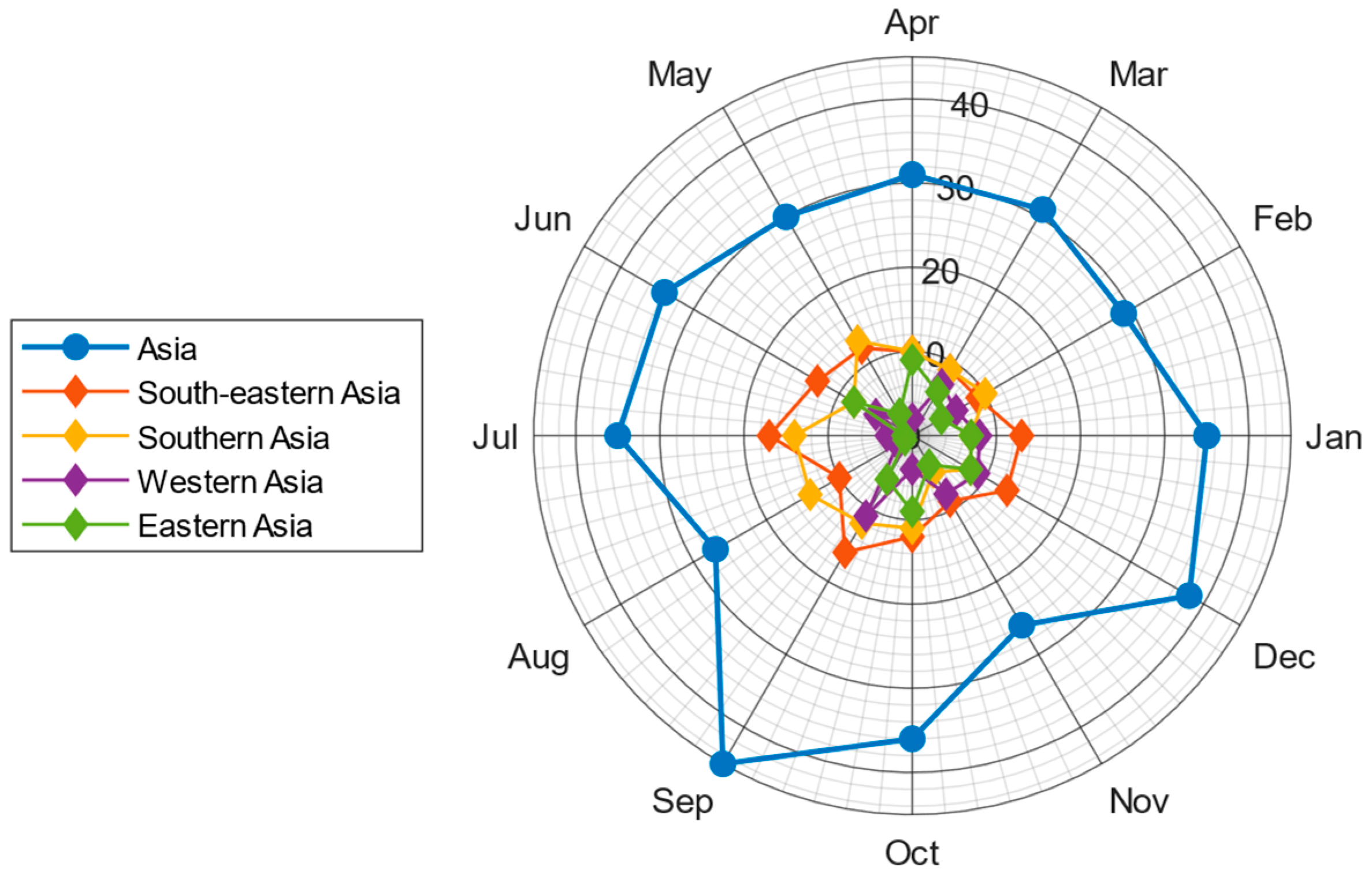
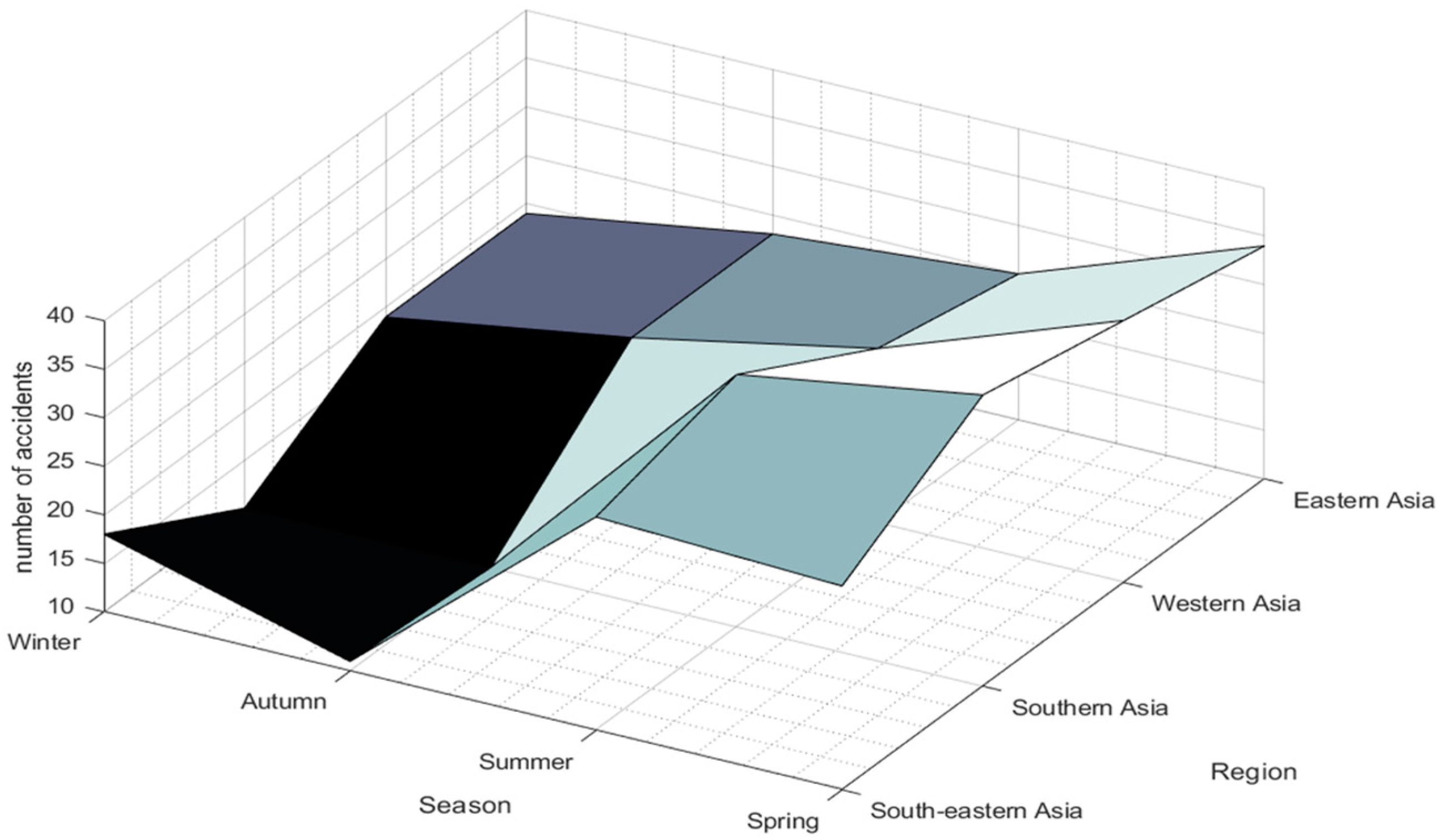
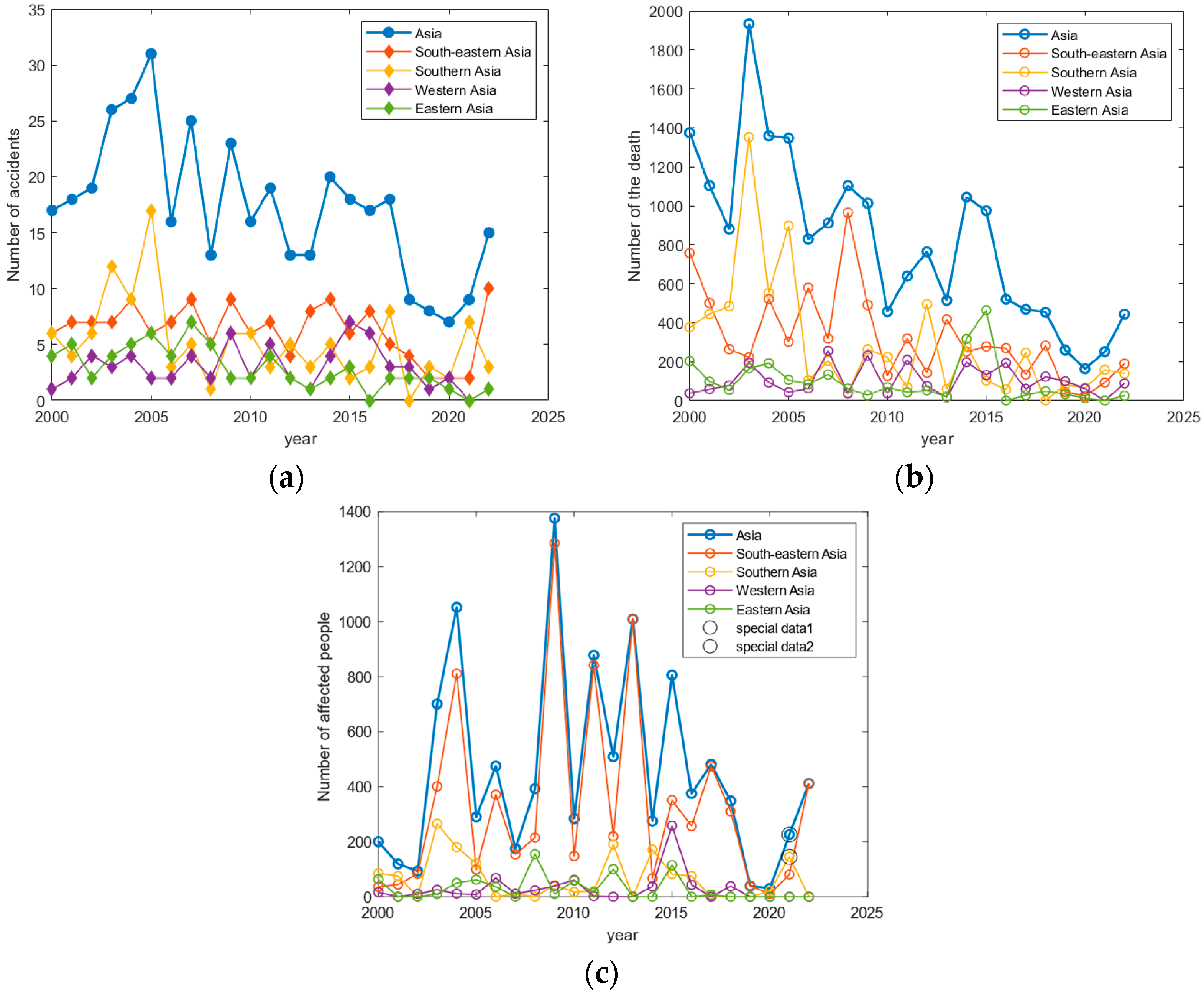

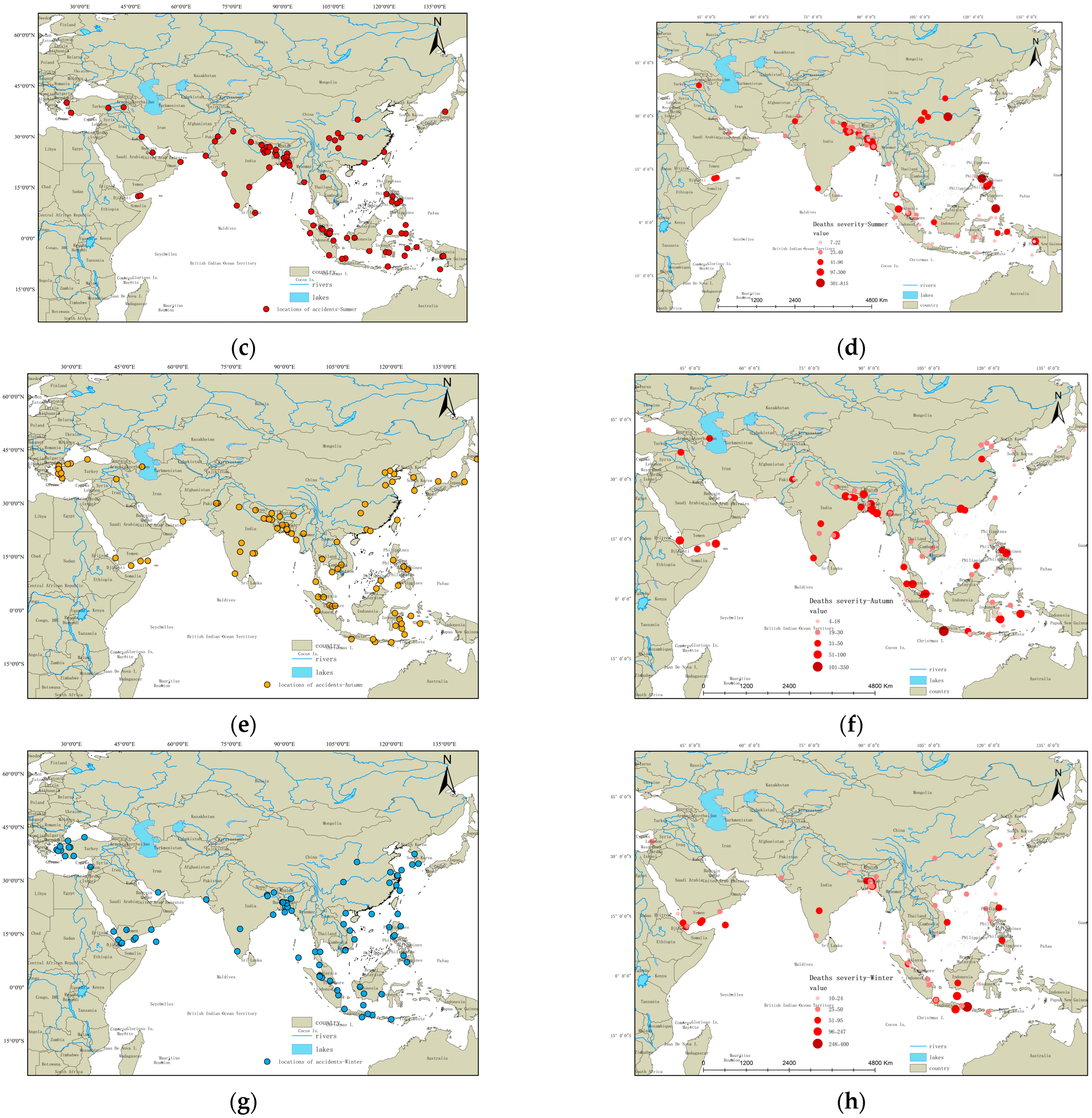



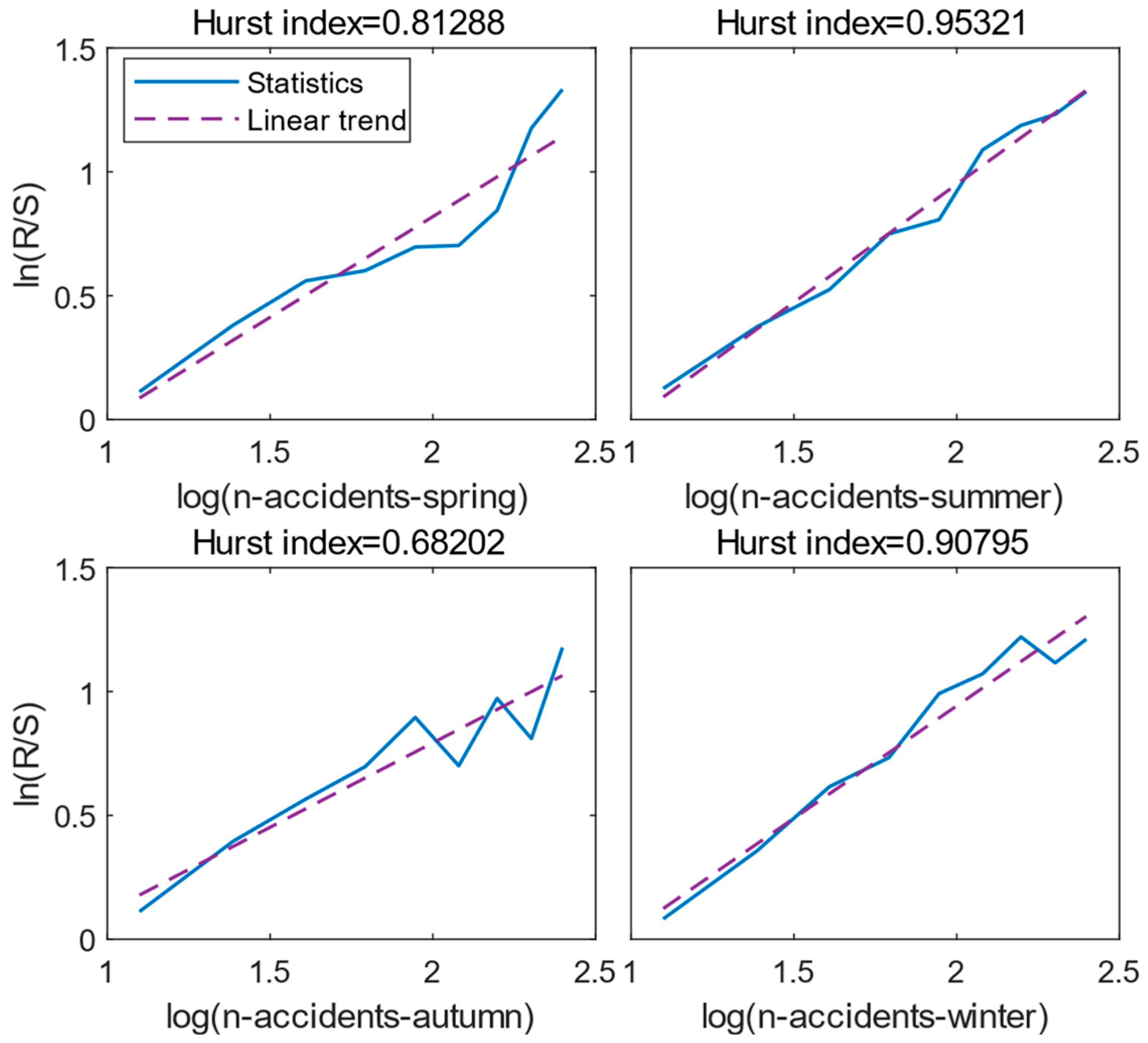
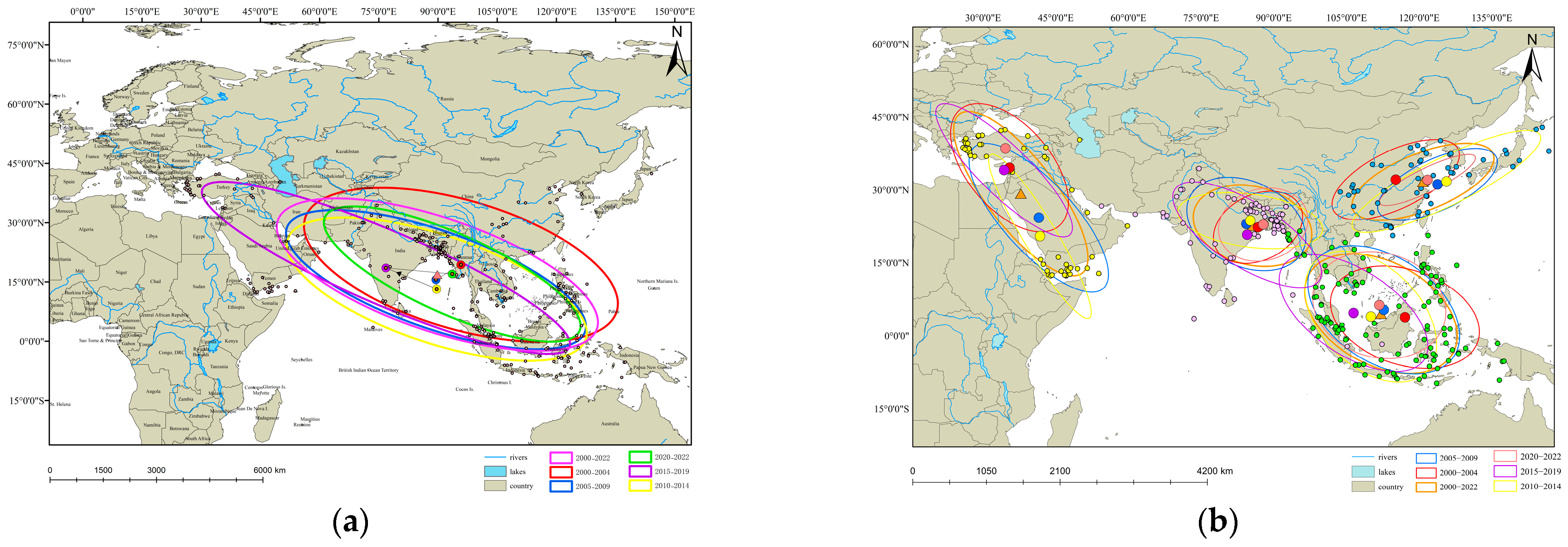
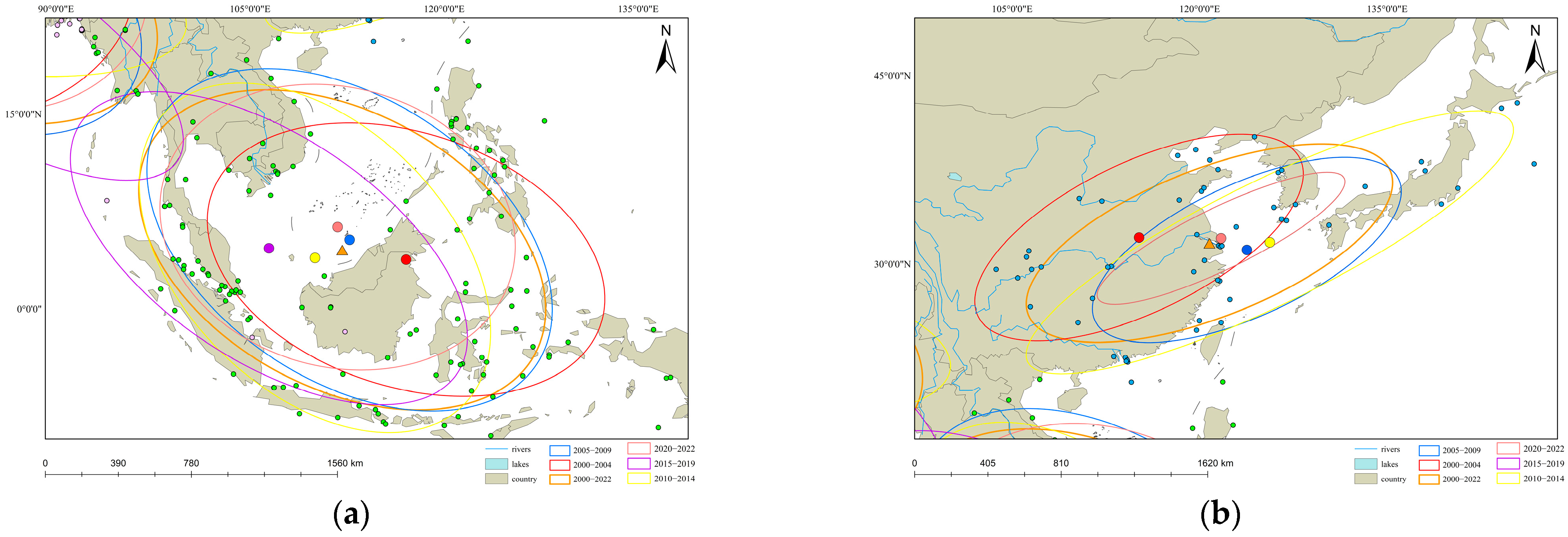
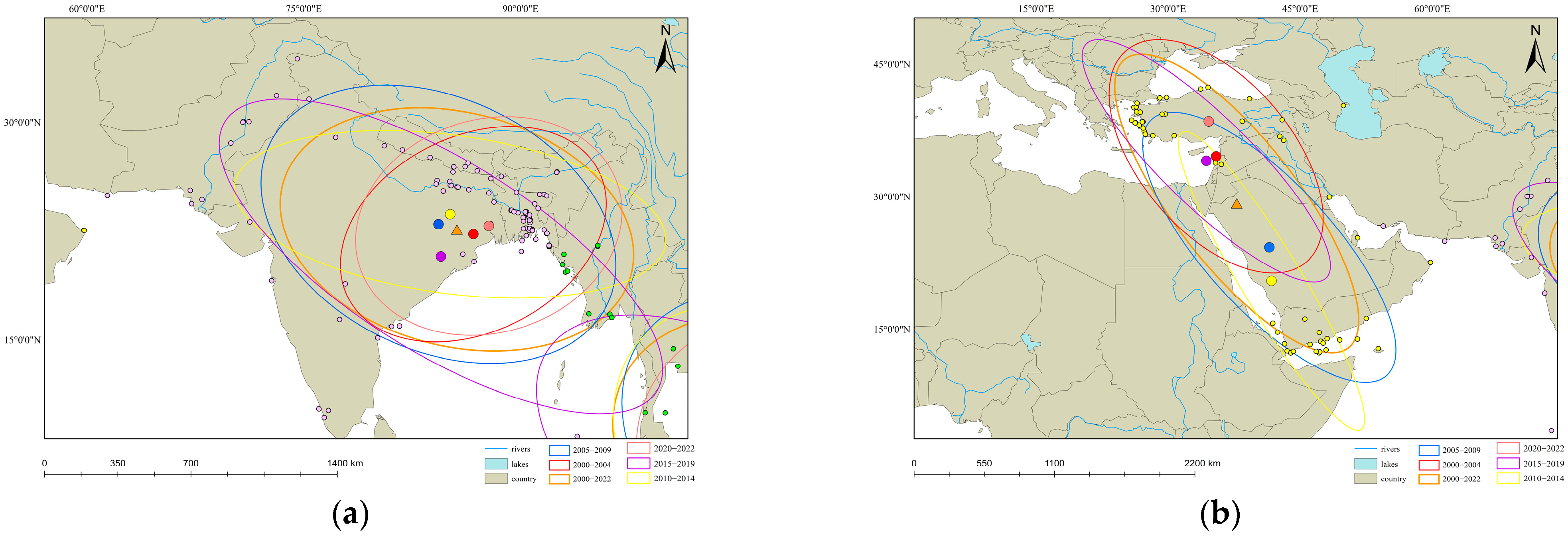
| Area | Year | r (Accidents/Death) | Trend (Downward-D/Rise-R) | Significance of 95% |
|---|---|---|---|---|
| Asia | 2000–2022 | −0.636 (−0.825) | D/D | Y/N |
| 2000–2004 | 1.000 (0.100) | R/R | Y/Y | |
| 2005–2009 | −0.500 (−0.100) | D/D | N/N | |
| 2010–2014 | −0.050 (0.700) | D/R | N/Y | |
| 2015–2019 | −0.800 (−1.000) | D/D | Y/Y | |
| 2020–2022 | 1.000 (1.000) | R/R | Y/Y | |
| Eastern Asia | 2000–2022 | −0.824 (−0.669) | D/D | Y/Y |
| 2000–2004 | 0.750 (−0.100) | R/D | Y/N | |
| 2005–2009 | −0.500 (−0.700) | D/D | N/Y | |
| 2010–2014 | −0.450 (0.100) | D/D | N/N | |
| 2015–2019 | −0.550 (−0.100) | D/D | N/N | |
| 2020–2022 | 0.250 (−0.500) | R/D | N/Y | |
| South-eastern Asia | 2000–2022 | −0.225 (−0.649) | D/D | N/Y |
| 2000–2004 | 0.850 (−0.400) | R/D | Y/N | |
| 2005–2009 | 0.350 (0.500) | R/R | N/N | |
| 2010–2014 | 0.700 (0.500) | R/R | Y/N | |
| 2015–2019 | −0.900 (−0.400) | D/D | Y/N | |
| 2020–2022 | 0.750 (1.000) | R/R | Y/Y | |
| Southern Asia | 2000–2022 | −0.513 (−0.601) | D/D | Y/Y |
| 2000–2004 | 0.250 (0.900) | R/R | N/Y | |
| 2005–2009 | −0.300 (−0.300) | D/D | N/N | |
| 2010–2014 | −0.500 (0.100) | D/R | N/Y | |
| 2015–2019 | −0.050 (−0.300) | D/D | N/N | |
| 2020–2022 | 0.500 (0.500) | R/R | Y/Y | |
| Western Asia | 2000–2022 | −0.197 (0.041) | D/R | N/N |
| 2000–2004 | 0.350 (0.900) | R/R | N/Y | |
| 2005–2009 | 0.450 (0.200) | R/R | N/N | |
| 2010–2014 | −0.050 (0.000) | D/— | N/— | |
| 2015–2019 | −1.050 (−0.600) | D/D | Y/Y | |
| 2020–2022 | −0.500 (0.500) | D/R | Y/Y |
| South-Eastern Asia | Southern Asia | Western Asia | Eastern Asia | |
|---|---|---|---|---|
| Accidents | 0.65315 | 0.87011 | 0.74831 | 0.73104 |
| Deaths | 0.81037 | 0.80481 | 0.65312 | 0.82565 |
| Seasons | Spring | Summer | Autumn | Winter |
|---|---|---|---|---|
| H | 0.81288 | 0.95321 | 0.68202 | 0.90795 |
| Year | Regions | ||||
|---|---|---|---|---|---|
| Asia | South-Eastern Asia | Eastern Asia | Southern Asia | Western Asia | |
| 2000–2022 | 89.835° E, 16.862° N | 112.121° E, 4.523° N | 120.785° E, 31.639° N | 85.600° E, 22.596° N | 37.789° E, 29.207° N |
| 2000–2004 | 95.808° E, 19.344° N | 117.056° E, 3.776° N | 115.153° E, 32.086° N | 86.736° E, 22.269° N | 35.452° E, 34.534° N |
| 2005–2009 | 89.482° E, 15.562° N | 112.690° E, 5.295° N | 123.776° E, 31.095° N | 84.321° E, 22.955° N | 41.490° E, 24.239° N |
| 2010–2014 | 89.683° E, 13.192° N | 110.014° E, 3.908° N | 125.611° E, 31.697° N | 85.131° E, 23.641° N | 41.738° E, 20.441° N |
| 2015–2019 | 76.816° E, 18.543° N | 106.453° E, 4.650° N | 121.713° E, 32.022° N | 84.493° E, 20.734° N | 34.334° E, 34.029° N |
| 2020–2022 | 93.597° E, 16.996° N | 111.765° E, 6.276° N | — — | 87.807° E, 22.833° N | 34.610° E, 38.495° N |
| Year | Regions | ||||
|---|---|---|---|---|---|
| Asia (Mm) | South-Eastern Asia (km) | Eastern Asia (km) | Southern Asia (km) | Western Asia (km) | |
| 2000–2022 | 42.699, 14.323 | 16.919, 10.617 | 15.575, 5.887 | 12.450, 8.050 | 7.055, 20.689 |
| 2000–2004 | 41.211, 16.251 | 15.852, 9.768 | 14.325, 5.938 | 9.709, 6.747 | 8.626, 15.743 |
| 2005–2009 | 40.018, 12.360 | 17.347, 10.866 | 13.391, 5.268 | 12.923, 8.706 | 7.244, 19.703 |
| 2010–2014 | 39.847, 13.640 | 16.127, 10.261 | 21.587, 4.909 | 15.060, 5.452 | 3.411, 19.659 |
| 2015–2019 | 50.655, 9.363 | 17.460, 8.703 | 10.957, 2.446 | 17.599, 6.590 | 19.008, 5.090 |
| 2020–2022 | 35.340, 10.134 | 13.933, 10.746 | — — | 9.369, 7.348 | — — |
Disclaimer/Publisher’s Note: The statements, opinions and data contained in all publications are solely those of the individual author(s) and contributor(s) and not of MDPI and/or the editor(s). MDPI and/or the editor(s) disclaim responsibility for any injury to people or property resulting from any ideas, methods, instructions or products referred to in the content. |
© 2023 by the authors. Licensee MDPI, Basel, Switzerland. This article is an open access article distributed under the terms and conditions of the Creative Commons Attribution (CC BY) license (https://creativecommons.org/licenses/by/4.0/).
Share and Cite
Peng, Z.; Jiang, Z.; Chu, X.; Ying, J. Spatiotemporal Distribution and Evolution Characteristics of Water Traffic Accidents in Asia since the 21st Century. J. Mar. Sci. Eng. 2023, 11, 2112. https://doi.org/10.3390/jmse11112112
Peng Z, Jiang Z, Chu X, Ying J. Spatiotemporal Distribution and Evolution Characteristics of Water Traffic Accidents in Asia since the 21st Century. Journal of Marine Science and Engineering. 2023; 11(11):2112. https://doi.org/10.3390/jmse11112112
Chicago/Turabian StylePeng, Zhenxian, Zhonglian Jiang, Xiao Chu, and Jianglong Ying. 2023. "Spatiotemporal Distribution and Evolution Characteristics of Water Traffic Accidents in Asia since the 21st Century" Journal of Marine Science and Engineering 11, no. 11: 2112. https://doi.org/10.3390/jmse11112112
APA StylePeng, Z., Jiang, Z., Chu, X., & Ying, J. (2023). Spatiotemporal Distribution and Evolution Characteristics of Water Traffic Accidents in Asia since the 21st Century. Journal of Marine Science and Engineering, 11(11), 2112. https://doi.org/10.3390/jmse11112112






